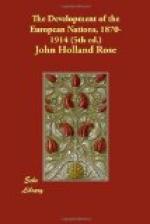[Footnote 237: See for the Russian case d’Elenew, Les Pretentions des Separatistes finlandais (1895); also La Conquete de la Finlande, by K. Ordine (1889)—answered by J.R. Danielsson, op. cit.; also Russland und Finland vom russischen Standpunkte aus betrachtet, by “Sarmatus” (1903).]
Little by little Alexander III. put in force this Slavophil creed against Finland. His position as Grand Duke gave him the right of initiating laws; but he overstepped his constitutional powers by imposing various changes. In January 1890 he appointed three committees, sitting at St. Petersburg, to bring the coinage, the customs system, and the postal service of Finland into harmony with those of Russia. In June there appeared an imperial ukase assimilating the postal service of Finland to that of Russia—an illegal act which led to the resignation of the Finnish Ministers. In May 1891 the “Committee for Finnish Affairs,” sitting at St. Petersburg, was abolished; and that year saw other efforts curbing the liberty of the Press, and extending the use of the Russian language in the government of the Grand Duchy.
The trenches having now been pushed forward against the outworks of Finnish freedom, an assault was prepared against the ramparts—the constitution itself. The assailants discovered in it a weak point, a lack of clearness in the clauses specifying the procedure to be followed in matters where common action had to be taken in Finland and in Russia. They saw here a chance of setting up an independent authority, which, under the guise of interpreting the constitution, could be used for its suspension and overthrow. A committee, consisting of six Russians and four Finns, was appointed at the close of the year 1892 to codify laws and take the necessary action. It sat at St. Petersburg; but the opposition of the Finnish members, backed up by the public opinion of the whole Duchy, sufficed to postpone any definite decision. Probably this time of respite was due to the reluctance felt by Alexander III. in his closing days to push matters to an extreme.
The alternating tendencies so well marked in the generations of the Romanoff rulers made themselves felt at the accession of Nicholas II. (Nov. 1, 1894). Lacking the almost animal force which carried Alexander III. so far in certain grooves, he resembles the earlier sovereigns of that name in the generous cosmopolitanism and dreamy good nature which shed an autumnal haze over their careers. Unfortunately the reforming Czars have been without the grit of the crowned Boyars, who trusted in Cossack, priest, and knout; and too often they have bent before the reactionary influences always strong at the Russian Court. To this peculiarity in the nature of Nicholas II. we may probably refer the oscillations in his Finnish policy. In the first years of his reign he gradually abated the rigour of his father’s regime, and allowed greater liberty of the Press in Finland. The number of articles suppressed sank from 216 in the year 1893 to 40 in 1897[238].




